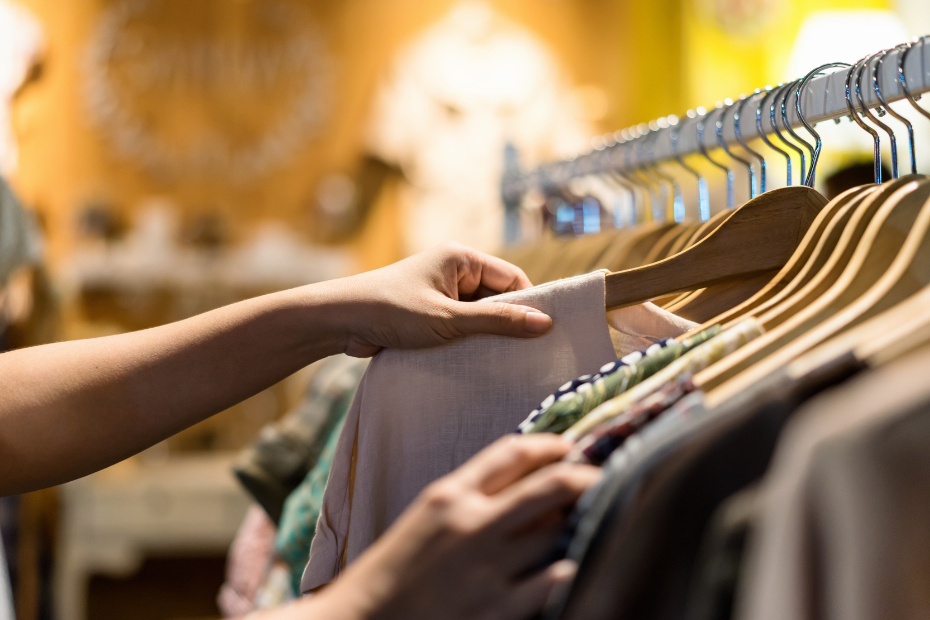Published June 16, 2023 • 8 Min Read
But if you haven’t done much thrift store shopping before, getting started can be a little intimidating. But when the rewards potentially involve finding gently-used cashmere sweaters and hardback books that would cost a handsome sum new — it’s worth checking out what’s on offer.
Here are 10 ways to make your thrift store experiences that bit more enjoyable.
1. Think like a forager
Instead of flipping through every hanger, perform an initial visual scan of the aisles.
In the thrift store, pretty much each item is unique. So even though the square footage may be similar to that of a regular clothing store, there are many more items to check out once you consider that there aren’t ten of each item in different sizes. To stop the prospect of browsing from becoming overwhelming, the first rule of thumb is, no thumbing — at least not initially. If you do, you’ll be there all day.
Head into the store, take a deep breath, and think like a forager. Wandering down an aisle, use your eyes to perform a gentle scan of general shapes, colours, and fabrics. If anything jumps out as being to your liking, you can take a closer look then and see if it’s for you.
But what exactly should you be keeping an eye out for?
2. Look for items made from natural materials
Natural materials tend to last longer than synthetics.
As thrift store items have already had a life before reaching the shop floor, it makes sense to opt for goods made from long-lasting materials.
When looking at clothes, that means stopping to check out anything that looks to be made of linen, leather, cotton, wool, silk, and hemp.
One of the big bonuses of making a beeline for natural materials? They’re more environmentally-friendly than synthetic blends — particularly as they don’t add harmful microfibres to rivers and oceans through laundry wastewater when they get washed.
Of course, lots of people find most wool a little too itchy. If you fit in that camp, maybe your ‘foraging eyes’ will still land on the softest, most distinctive of wools: cashmere.
Top tip: how to tell if a fabric is made from natural materials
One issue you might run into while browsing is in finding vintage items without labels describing their materials. If that’s the case, there are a few ways to tell if the fabric is natural rather than a synthetic blend:
-
Cotton-polyester blends might look like pure cotton at first glance, but check under the arms — if there’s lots of pilling, it’s likely a blend.
-
Or if you’re wondering whether an item is actual linen, look closely and if it’s genuine you should see tiny knots in the weave.
-
As for genuine silk, when held up to the light, it isn’t shiny but subtly lustrous — like a pearl. Silk also feels warm to the touch when you rub the material with your hands.
You can also go beyond the clothing section when looking for natural items. In the homeware section, it’s common to find attractive woven baskets of all sizes. Glass and clay vases are also typical finds. Some thrift stores also sell furniture: solid wood items are going to last a long time, but make sure you really like the design and not just the price tag.
3. Assess if it’s an item you’d really use
If not, leave the item for another customer.
The staff at thrift stores do a general check of the items that come in, so everything on the shop floor is generally going to be in decent shape, though of course that’s subjective. If there’s more pilling than you’d like to see, stains that look irremovable, or a small hole that you just know you’re never going to darn or take to the tailors’ to fix — leave the item for another person who is into mending. After all, that pre-loved item isn’t really getting a new life if it’s just going to sit in the back of your wardrobe.
4. Wear form-fitting clothes
That way, you can try things on easily.
Lots of thrift stores don’t have changing rooms, so if you’re going to be trying different items on, wear form-fitting clothes. That way you can layer on top of what you’re already wearing.
Also, if you’re looking at older items: size up. Clothes were generally made to run smaller in the past.
5. Seek out brand names
Where the item was made can also tell its own story.
Finding vintage ‘Made in Canada’ items from great-quality brands is entirely possible at the thrift store — you’re especially likely to get lucky if you’re already scanning for natural fabrics. Vintage items that were made in the United States, England, or Italy also tend to be of excellent quality.
If there is a label on the item and you’d like to learn more about the brand you’re looking at, there are websites that can help you do that. Vintage Fashion Guild’s extensive label resource is especially helpful. You can also join vintage clothing social media communities and post about an unfamiliar label there.
6. Keep an eye out for items that you’re always losing
For most people, those are sunglasses and gloves.
Some people can hold onto the same pair of winter gloves or summer sunglasses for years. Others have accessories that always seem to have a strange habit of sneaking off. If you’re in the latter camp and have given up on buying designer items because they just never seem to stay with you for a full season, buy back-up gloves and sunglasses from the thrift store.
7. Find out the best day to go
Staff can let you know when they tend to re-stock the store.
Some days you can go into the thrift store and find a slew of great items you’d ordinarily have to pay top dollar for. Some days you might go in, fruitlessly scan the aisles, and leave with nothing more than a couple of vintage National Geographic magazines (they make great birthday gifts for friends by the way, if you can find an issue dated with the month and year from when they were born).
If you’re not finding any decent items on browsing the aisles, perhaps you’ve gone in when the store hasn’t been re-stocked for a little while. Ask the staff about the days in which they do bring fresh items into the aisles, and you can shop that much better next time.
8. Try different types of thrift store
One overwhelming experience in the past shouldn’t put you off.
Some of the larger, big-name thrift stores can be overwhelming — even when armed with the above tips. For a more relaxed experience, next time you’re in a small town, check out the local thrift store. It’s not going to be an overwhelmingly big space, the items on show won’t number too high, and the staff will likely be happy to let you know if they have something in stock that fits what you’re looking for.
9. Double check before you buy
Test to see if the item is in full working order before you check out.
The staff at small-town thrift stores generally test electronics — and that all the pieces in board games and jigsaw puzzles are there. If that’s the case, there’ll be signs saying so. But in some of the bigger thrift stores in the city, you’ll see signs saying that the electronics and games have not been checked. Ask a staff member if you can plug the item you like into a power outlet to test it. If that’s not a possibility, make sure to check the store’s return policy. Many places have ‘final sale’ policies, and that’ll impact whether you want to take the chance on your finds.
10. In the homeware section, think beyond electronics
Some of the best homeware items to stock up on are candles and picture frames.
You’ll often find stacks of unused candlesticks for much cheaper than you would if you were buying them new. They might not be made by designer French perfumer brands, but you’ll at least be glad to have them in a back drawer for use in a power cut.
Also, if you’re looking to create a gallery wall in your home, the thrift store is a great place to find solid wood frames. Yes, there might already be a picture inside the frame that’s not to your taste. Just replace it with your favorite print or painting, and it’ll be good as new.
This article is intended as general information only and is not to be relied upon as constituting legal, financial or other professional advice. A professional advisor should be consulted regarding your specific situation. Information presented is believed to be factual and up-to-date but we do not guarantee its accuracy and it should not be regarded as a complete analysis of the subjects discussed. All expressions of opinion reflect the judgment of the authors as of the date of publication and are subject to change. No endorsement of any third parties or their advice, opinions, information, products or services is expressly given or implied by Royal Bank of Canada or any of its affiliates.
Share This Article






